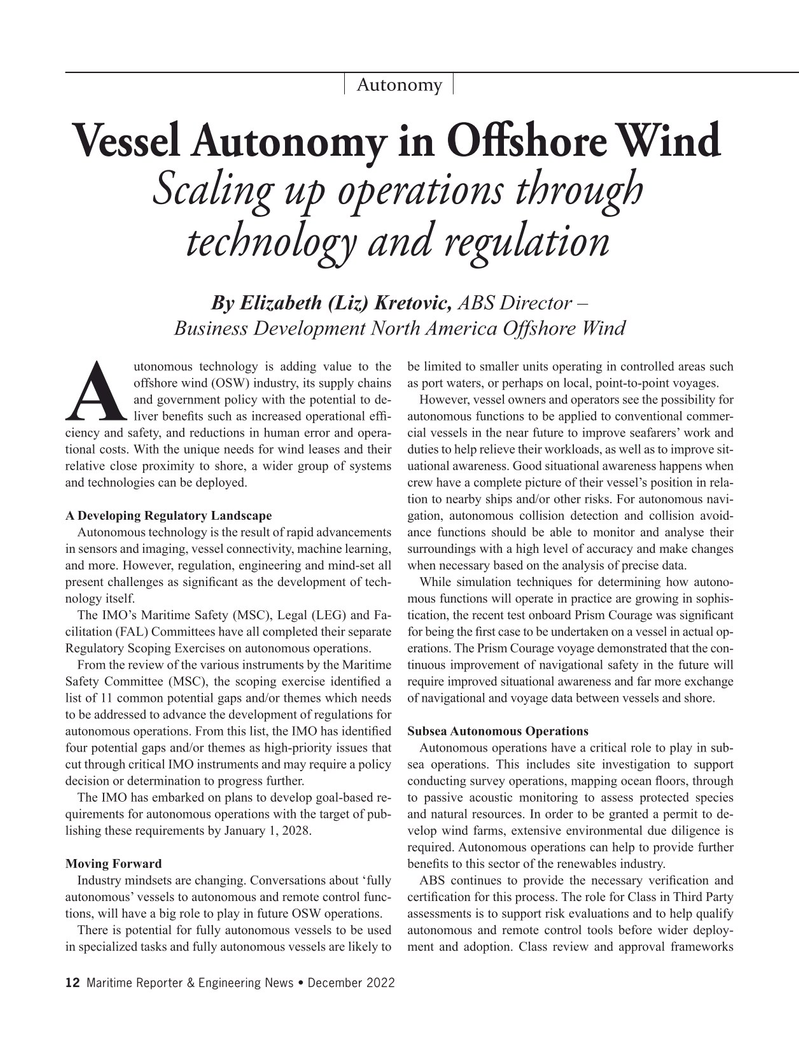
Page 12: of Maritime Reporter Magazine (December 2022)
Great Ships of 2022
Read this page in Pdf, Flash or Html5 edition of December 2022 Maritime Reporter Magazine
Autonomy
Vessel Autonomy in Of shore Wind
Scaling up operations through technology and regulation
By Elizabeth (Liz) Kretovic, ABS Director –
Business Development North America Offshore Wind utonomous technology is adding value to the be limited to smaller units operating in controlled areas such offshore wind (OSW) industry, its supply chains as port waters, or perhaps on local, point-to-point voyages.
and government policy with the potential to de- However, vessel owners and operators see the possibility for
A liver bene? ts such as increased operational ef? - autonomous functions to be applied to conventional commer- ciency and safety, and reductions in human error and opera- cial vessels in the near future to improve seafarers’ work and tional costs. With the unique needs for wind leases and their duties to help relieve their workloads, as well as to improve sit- relative close proximity to shore, a wider group of systems uational awareness. Good situational awareness happens when and technologies can be deployed. crew have a complete picture of their vessel’s position in rela- tion to nearby ships and/or other risks. For autonomous navi-
A Developing Regulatory Landscape gation, autonomous collision detection and collision avoid-
Autonomous technology is the result of rapid advancements ance functions should be able to monitor and analyse their in sensors and imaging, vessel connectivity, machine learning, surroundings with a high level of accuracy and make changes and more. However, regulation, engineering and mind-set all when necessary based on the analysis of precise data.
present challenges as signi? cant as the development of tech- While simulation techniques for determining how autono- nology itself. mous functions will operate in practice are growing in sophis-
The IMO’s Maritime Safety (MSC), Legal (LEG) and Fa- tication, the recent test onboard Prism Courage was signi? cant cilitation (FAL) Committees have all completed their separate for being the ? rst case to be undertaken on a vessel in actual op-
Regulatory Scoping Exercises on autonomous operations. erations. The Prism Courage voyage demonstrated that the con-
From the review of the various instruments by the Maritime tinuous improvement of navigational safety in the future will
Safety Committee (MSC), the scoping exercise identi? ed a require improved situational awareness and far more exchange list of 11 common potential gaps and/or themes which needs of navigational and voyage data between vessels and shore.
to be addressed to advance the development of regulations for autonomous operations. From this list, the IMO has identi? ed Subsea Autonomous Operations four potential gaps and/or themes as high-priority issues that Autonomous operations have a critical role to play in sub- cut through critical IMO instruments and may require a policy sea operations. This includes site investigation to support decision or determination to progress further. conducting survey operations, mapping ocean ? oors, through
The IMO has embarked on plans to develop goal-based re- to passive acoustic monitoring to assess protected species quirements for autonomous operations with the target of pub- and natural resources. In order to be granted a permit to de- lishing these requirements by January 1, 2028. velop wind farms, extensive environmental due diligence is required. Autonomous operations can help to provide further
Moving Forward bene? ts to this sector of the renewables industry.
Industry mindsets are changing. Conversations about ‘fully ABS continues to provide the necessary veri? cation and autonomous’ vessels to autonomous and remote control func- certi? cation for this process. The role for Class in Third Party tions, will have a big role to play in future OSW operations. assessments is to support risk evaluations and to help qualify
There is potential for fully autonomous vessels to be used autonomous and remote control tools before wider deploy- in specialized tasks and fully autonomous vessels are likely to ment and adoption. Class review and approval frameworks 12 Maritime Reporter & Engineering News • December 2022
MR #12 (1-17).indd 12 12/4/2022 6:12:55 PM

 11
11

 13
13
